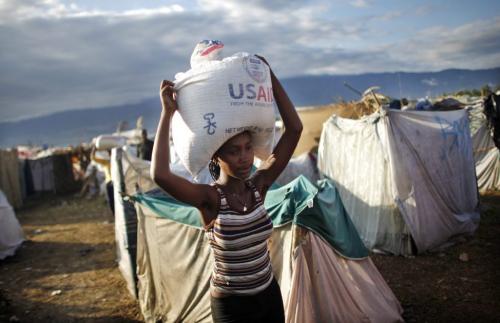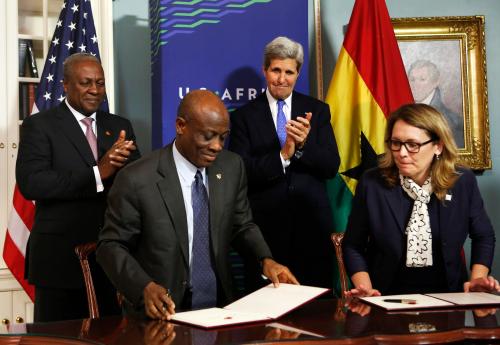The Trump administration’s proposals to drastically cut foreign aid have once again sparked debates about aid effectiveness. Right on cue, some commentators have fallen back on the old and tired claim that there is no evidence that aid works. Perhaps the most forceful (and egregious) of these statements came from Stephen Moore of the Heritage Foundation, who declared on National Public Radio, “There’s zero evidence that any of these foreign aid programs have had any effect on development, whether it’s in the Middle East or Africa or South America. And there’s just zero evidence that any of that development aid has had any effect on raising the living standards…”
Moore’s claim is utterly false. There is lots of evidence from independent research showing the positive impacts of aid on development and raising living standards. As this evidence has grown in recent years, a strong bipartisan consensus has emerged that aid is an effective and important tool of U.S. foreign policy and national security. In turn, the major debates about aid have shifted from the outdated “does aid work” to much more helpful questions about how aid mechanisms could be strengthened further and how they should evolve in a rapidly changing world. Those latter questions are still the right ones. But since the old questions have come back, it is important to once again look at the evidence on aid effectiveness.
To begin with, let’s point out the obvious: not all aid-financed projects work, some completely fail, and not all of the evidence points to positive outcomes. This is to be expected, just as some diplomatic efforts fail, not all military interventions work, and not all private sector investments succeed. So don’t be fooled by people who point to examples of individual aid projects that have not worked as evidence of systemic failure any more than someone who would point to Enron, Lehman Brothers, or any of the 20,000 U.S. companies that file for bankruptcy every year to argue that private investment doesn’t work. Yes, there is failure, especially in the most challenging countries. But there is a great deal of success as well.
For starters, there is widespread agreement that aid programs focused on health have saved millions of lives. The President’s Emergency Plan for AIDS Relief (PEPFAR), which among other things provides antiretroviral treatment for 11.5 million people, has been a key reason why global deaths from the disease have fallen by almost half since 2005. There is rigorous research to back this up: an exhaustive four-year study by the Institute of Medicine concluded that “PEPFAR has saved and improved the lives of millions; supported HIV prevention, care, and treatment; strengthened systems; and engaged with partner countries to facilitate HIV policy and planning.” At the same time, malaria mortality has declined by nearly 50 percent since 2000—saving almost 7 million lives—in part through the efforts of U.S. Agency for International Development’s President’s Malaria Initiative. Tuberculosis infections have fallen by 25 percent, the world is on the brink of eradicating polio, and 4 million fewer children die from diarrheal diseases each year than three decades ago. Leadership and hard work in developing countries deserve much of the credit, but there is no doubt that aid was a major force in saving these lives.
The biggest debates have centered on aid and economic growth. The evidence was hotly contested a decade ago, but in recent years the preponderance of research has shown a positive impact of aid on growth. My colleagues Michael Clemens, Rikhil Bhavnani, Sami Bazzi, and I looked back at three of the leading papers that concluded that aid had no impact on growth and found that with a few modest (and sensible) adjustments to the underlying models in those papers, a consistent positive relationship between aid and growth emerged. Our findings are consistent with recent research by Henrik Hansen, Finn Tarp, Sam Jones, Robert Lensik, Howard White, Sebastian Galiani, Sandrina Moreira, Channing Arndt, Markus Brückner, and many others, all published in respected academic journals, which you can find here, here, here, here, here, here, here, and here (there are others). The skeptics rarely mention this research and sometimes pretend that it doesn’t exist.
Of course, there are research papers that conclude that there is little connection between aid and growth, such as those by Peter Boone, Raghuram Rajan and Arvind Subramanian, and Axel Dreher and Sarah Langlotz. If you want to understand the debate, you should read them. But most of the recent research concludes that aid supports growth, as shown in the excellent summary by Ardnt, Jones, and Tarp. They find that the research shows that a “sustained inflow of foreign aid equivalent to 10 percent of GDP is roughly expected to raise growth rates per capita by one percentage point on average.” For developing countries with per capita growth rates of 3-4 percent per year, an extra percentage point of growth is an important addition. Other reviews of the recent literature have reached similar conclusions. Even The Economist magazine, long skeptical of aid, changed its tune a couple of years ago, concluding that most evidence shows that aid boosts growth.
There is more. In 2015, USAID’s Feed the Future program helped more than 9 million famers increase their incomes by more than $800 million and improved the nutrition of more than 18 million children. Aid has also supported progress in education, especially girls’ education. For example, in Afghanistan, less than 1 million children attended schools in 2002, and almost none were girls. But since then, the Afghan government, USAID, and other donors have built more than 16,000 schools, recruited and trained more than 154,000 teachers, and increased net enrollment rates to nearly 60 percent. Today there are 9 million children in school, including more than 3.5 million girls. And beyond the money itself, my colleague John McArthur, senior fellow at Brookings, has shown a clear acceleration of development progress during the period of the U.N.’s Millennium Development Goals, which was a coordinated effort by donors and host governments to achieve specific development targets.
A final argument is political—that aid keeps bad governments in power. But again, recent research suggests the opposite: since the end of the Cold War, aid has helped support democratic transitions both by reinforcing broad development progress and by supporting civil society organizations, stronger judicial systems, and multiparty elections. Thad Dunning at the University of California, Berkeley, found that aid had a positive effect on democracy in Africa after the Cold War. Sarah Bermeo at Duke University found that after 1992 foreign aid from democratic donors increased the likelihood of a democratic transition. Research by Erasmus Kersting and Christopher Kilby at Villanova University and by Simone Dietrich at the University of Missouri and Joseph Wright at Pennsylvania State University of also found that aid had a positive impact on democratic transitions and consolidation.
It is important not to overstate the impact of aid. Foreign aid has not been the major driver of development progress over the last 20 years, nor will it be in the future. Long-term development progress depends primarily on the economic and political institutions that are built over time in low-income countries, and the actions taken by those countries themselves. Aid programs (alongside diplomacy and other tools of international engagement) are not the driving force behind development, but they can help support development progress along the way.
So don’t let the skeptics fool you with their shouted and erroneous claims that there is no evidence that aid works. The Trump administration’s proposals to dramatically cut aid are astonishingly shortsighted and counter-productive, both because doing so would harm development progress amongst the global poor and because it would undermine U.S. national security. That was the message of 120 retired generals and admirals in a recent letter to Congress calling on them not to cut funding for diplomacy and foreign aid, which was echoed by a similar letter from more than 100 faith leaders. Fortunately, both Democratic and Republican members of Congress understand the importance of aid (and diplomacy) programs, and just last week wisely voted to increase funding for the international affairs budget for the fiscal year ending on September 30, 2017. These members of Congress, our national security leaders, faith leaders, and others know that the right way forward is to strengthen our aid programs and build on their success, not to cut them and leave developing countries in the lurch while undermining our own security.
The Brookings Institution is committed to quality, independence, and impact.
We are supported by a diverse array of funders. In line with our values and policies, each Brookings publication represents the sole views of its author(s).







Commentary
Once more into the breach: Does foreign aid work?
May 8, 2017